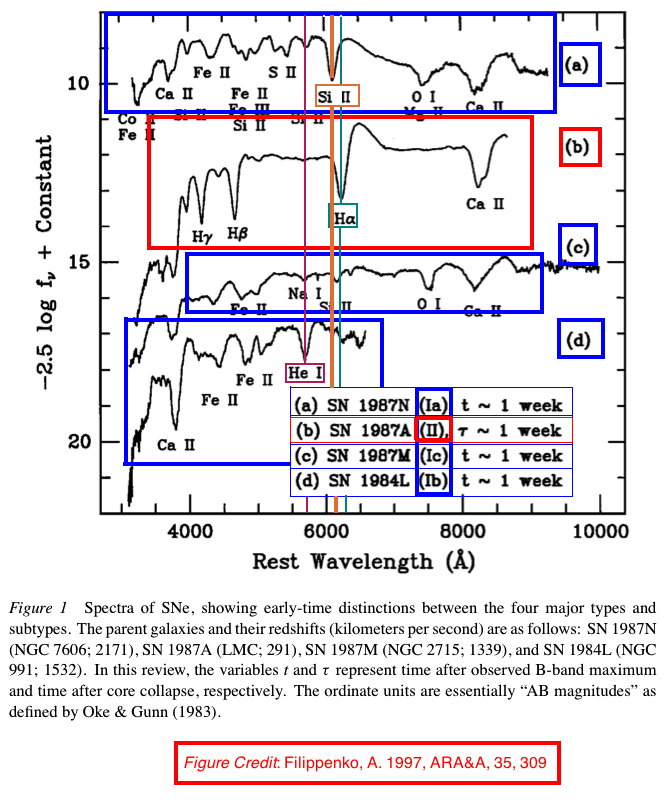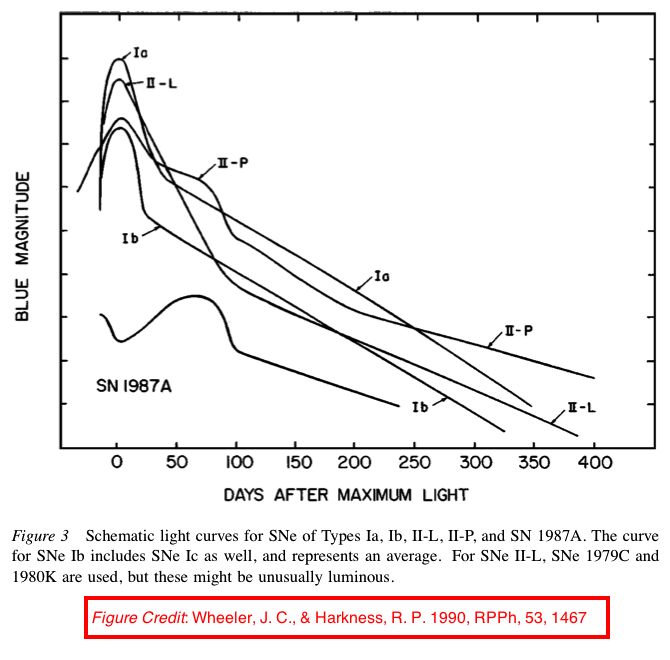
Supernova are fundamentally classified by their atomic spectra into two groups: Type I and Type II, examples of which are seen in optical light in the figure below (the x-axis of the plot is in angstroms (Å), which are defined as 1Å=1.0×10-10m=0.1nm , while the y-axis is a measure of the brightness at various wavelength observed with a spectrograph). The defining characteristic of a Type I supernova is a lack of hydrogen (vertical teal lines near maximum light as shown in the figure below at 6563Å) in their spectra, whereas Type II supernovae do show spectral lines of hydrogen. In the figure, the spectral signatures are seen as absorption lines (a dip in brightness from the continuum at a wavelength that corresponds to a specific electronic transition in a specific element). We believe that all of the Type II supernova result from the collapse of a massive star's core that leave behind a compact stellar remnant in the form of a neutron star or black hole.
We distinguish three sub-types of Type I supernovae: Type Ia, Type Ib, and Type Ic. The spectra of a Type Ia supernova contain a distinct silicon absorption line around 6150 Å (vertical orange line as seen in the figure) ; this line is unique among Type I supernovae and so defines the subgroup-a of the Type I supernovae. Type Ib and Type Ic are characterized by the presence or absence of a helium line around 5876 Å (vertical purple . The light curves among the different Type I supernovae are much more homogeneous than the light curves among Type II supernovae.

Another key piece of information astronomers use to classify supernovae is their light curves. Unlike the light curve you saw with GK-Per, a supernova light curve is not periodic since the explosion only occurs once. Light curves are used to subdivide the Type II supernovae based upon how their brightness changes with time (e.g. Type IIp supernovae are given the subgroup p, which stands for "plateau", since their light curves maintain a brightness close to that of their maximum brightness for a relatively long period of time, compared to others that fall off more rapidly after the time of maximum light). The figure below shows sample light curves from various types of supernovae.

Light curves and spectra from Type Ia supernovae are remarkably homogeneous, especially when compared to the other types and sub-types of supernovae. These homogeneities were the first indication that there seems to be a unique process or set of conditions that lead to Type Ia supernovae. As it turns out, surprisingly perhaps, the likely culprit for these supernovae is the lowly white dwarf star. To understand why these stars best explain the homogeneities in Type Ia supernovae, we must first look more closely at the conditions inside of a white dwarf.
We have discovered that the death of a massive star is not the only way to make a supernova. While it is true that most stars in our galaxy are about the same size as our sun and will end their lives enigmatically as burnt cinders, this does not necessarily spell the end of every low mass star's evolution.
As we noted before in section 3.2 of the course wiki, a white dwarf is supported against gravity by electron degeneracy pressure. To understand electron degeneracy pressure in terms of the Pauli Exclusion Principle, let us consider a parable of overdevelopment in the recently built "Micro-Estates" gated community for electrons of evolved stars...
In The Beginning...In the beginning the electrons didn't mind moving into the Micro-Estates, since it was at first spacious and quite posh. Electrons value their personal space above all else, so the estates fit their needs perfectly. It was relatively easy for the electrons to keep well away from each other and maintain social norms.
|
After the Collapse...After the great collapse of the core corporation where millions of electrons were employees, conditions in the once envied Micro-Estates deteriorated. Electrons from all around were forced to move into the estates when their suburban lifestyle became untenable. Overcrowding began to run rampant, and the electrons degenerated into survival mode. Each electron was forced to hold the little ground he or she had left at any cost; forgotten were the days where electrons were bound by society to stay the customary distance away from one another.
|
In the story this last piece of ground that an electron has is its micro-estate. In reality, the analog to these are called microstates; and no two electrons, or any other fermion for that matter, can occupy the same state. A microstate is single discrete environment an electron can exist in, defined by several quantum mechanical properties (quantum numbers), and is a unique realization of an energy that a single electron can have. This fundamental property of electrons leads to an outward pressure that stops the star from collapsing further due to its own gravity. Under these conditions the force of repulsion that two electrons would normally experience (like charges repel!)and the thermal properties that usually determine pressure, are negligible compared to this degeneracy condition.
The maximum mass of a white dwarf is about 1.4 times that of our sun, and is called the Chandrasekhar Limit. Beyond this mass, electron degeneracy pressure would not be able to prevent the star from collapsing to a smaller size. So if the star could somehow acquire even more mass than 1.4 solar masses, we could get further fireworks. Thus, an isolated white dwarf may continue to just placidly burn like a dying ember, but what will happen if, like a majority of stars in our galaxy, it is part of a binary star system? Now, the possibility exists of an interaction between the white dwarf and its companion star which orbit each other in a stable gravitationally bound configuration (like the earth and the sun). In some situations a white dwarf will be close enough to its companion star that matter will transfer from the companion onto the white dwarf star in a process called accretion. As the white dwarf star accretes more material from the companion its radius will shrink and its mass will grow. This is where the Chandrasekhar limit comes into play, since it sets the maximum mass a white dwarf can have.
However, unlike the core of a massive star, which can have a variety of sizes and hence a range of different explosions,a white dwarf will ignite as its mass approaches the Chandrasekhar limit, which is almost the same for all these objects. The once dying star will begin to undergo fusion again, but this time the star cannot expand because it is bound as tightly as possible, and this newly kindled fusion creates more energy than that which holds the star together gravitationally. All of this leads to the violent explosion of the star in an event we humans have named a type Ia supernova! (This author must admit though that the exact conditions for this spark that ignites the event is poorly understood, but a quite active and thriving field of study in astrophysics.)
While the consensus view in astrophysics today is that Type Ia supernovae result from a thermonuclear detonation of a Carbon/Oxygen composite white dwarf star that accreted mass from a companion, identifying the exact candidate for the companion star remains a point of contention. The two leading choices for this companion star are either an evolved main sequence star (single degenerate model), or a second white dwarf star that coalesces with the previously mentioned Carbon/Oxygen white dwarf star (double degenerate model).
Current evidence suggests that the double degenerate picture is the most likely mechanism for Type Ia supernovae; however this does not rule out the possibility that Ia supernovae can explode with the mechanism explained in the single degenerate model (at least some of the time anyway).
Cartoon of a Single Degenerate System
Image Credit: STFC/David Hardy |
Cartoon of a Merging Doubly Degenerate System
Image Credit: NASA/Tod Strohmayer (GSFC)/Dana Berry (Chandra X-Ray Observatory) |